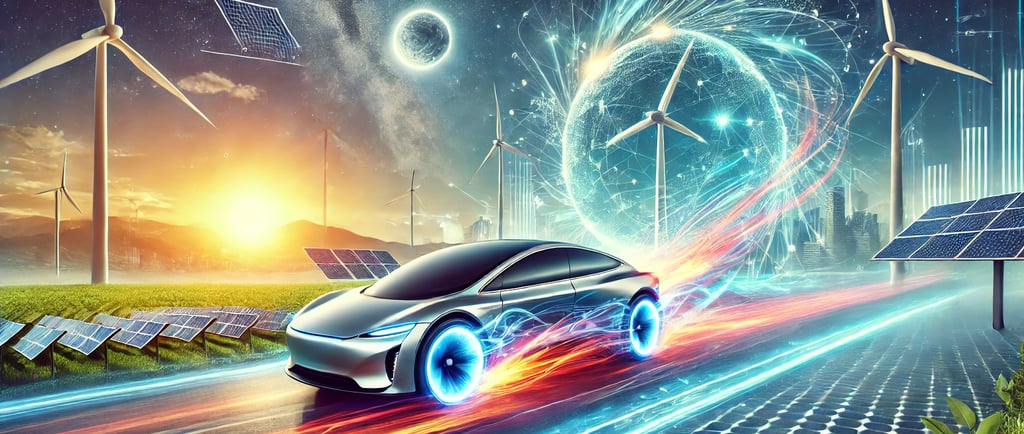Revolutionizing Green Energy: The Genius of Dhope.org’s Aerodynamic Power Harvesting Technology
Discover how Dhope.org's groundbreaking technology is transforming transportation by harnessing aerodynamic forces to generate clean energy. Learn how this innovation powers on-the-go hydrogen production, reduces carbon emissions, and paves the way for self-sustaining vehicles. Explore the future of energy and transportation in a world free from fossil fuels.


In the ever-evolving world of renewable energy, the pursuit of sustainable solutions to power our vehicles and industries is more crucial than ever. But what if we told you that one of the most innovative and environmentally friendly energy sources might already be right in front of us – literally on the go? Enter the groundbreaking technology developed by Dhope.org, which is set to revolutionize how we think about energy production, and possibly change the future of transportation as we know it.
The Aerodynamic Force: An Untapped Energy Source
Every vehicle in motion, whether it's a car, truck, or even an airplane, experiences a fundamental principle of physics: aerodynamic force. When a vehicle moves through the air, the air pushes back with a force that resists its forward motion. This aerodynamic drag is typically seen as an obstacle – something that requires energy to overcome. However, what if we could harness this very force, rather than fighting against it?
Dhope.org has done just that. They’ve invented a genius way to harvest the opposite aerodynamic force experienced by moving vehicles, converting it into usable energy. Instead of allowing the vehicle’s motion to wastefully dissipate energy through air resistance, this technology cleverly captures and transforms that energy into electricity.
How It Works: The Simple Genius of Energy Harvesting
The system designed by Dhope.org uses a series of cutting-edge components placed strategically on vehicles to capture the energy created by aerodynamic drag. Essentially, it works by utilizing the air pressure differential caused by the vehicle’s movement, turning this otherwise wasted force into electrical energy. With minimal energy loss and an efficient design, the system allows vehicles to harvest this power on the go, converting the resistance the vehicle faces into usable electricity in real-time.
But here’s where it gets even more exciting.
From Electricity to Hydrogen: A Sustainable Fuel Solution
Once the energy is captured, it doesn’t just stop there. The electricity generated by this aerodynamic force harvesting system can be used for a wide range of applications – most notably, it can be employed to produce hydrogen gas through electrolysis. By using renewable electricity to split water molecules into hydrogen and oxygen, this technology can generate hydrogen on-demand without relying on fossil fuels.
Hydrogen, as a clean-burning fuel, is an ideal solution for the transportation sector. When used in combustion engines, hydrogen produces only water vapor as a byproduct, making it an incredibly clean alternative to petrol and diesel. The ability to produce hydrogen on-the-go, directly from the vehicle’s movement, is an exciting breakthrough in achieving true sustainability. It removes the need for extensive hydrogen infrastructure, allowing vehicles to produce and consume hydrogen right from the source – their own energy generation system.
A Future Without Petrol and Diesel
The implications of Dhope.org’s technology are immense. Imagine a world where cars and trucks are completely energy self-sufficient, using aerodynamic forces to generate electricity that powers onboard hydrogen production systems. These vehicles could run entirely without petrol or diesel, and even without the need for charging stations, as they would essentially be creating their own fuel.
This could mark the end of the dependency on oil, reducing greenhouse gas emissions and mitigating the environmental damage caused by the extraction and combustion of fossil fuels. The benefits of this innovation are twofold: not only does it provide a cleaner, more sustainable way to power vehicles, but it also offers a dynamic, on-the-move solution that allows for continuous, self-sustaining energy production.
What This Means for the Future of Transportation
Dhope.org’s invention is a beacon of hope in the transition towards greener, more sustainable energy solutions. The aerodynamic power harvesting technology has the potential to:
Reduce Carbon Emissions: By powering vehicles with hydrogen and reducing reliance on fossil fuels, this system significantly decreases the carbon footprint of transportation.
Create Energy-Efficient Vehicles: Vehicles equipped with this technology could run more efficiently, as they would be generating their own electricity in real time, reducing the need for energy from external sources.
Empower Clean Hydrogen Production: With the ability to generate hydrogen on demand, this could spur the widespread adoption of hydrogen-fueled vehicles without requiring the extensive infrastructure currently needed.
Disrupt the Energy Landscape: This could be the start of a revolution in how we approach energy generation – one that doesn’t rely on centralized power plants, fuel extraction, or traditional energy grids, but instead embraces decentralized, self-sustaining energy systems.
The Road Ahead: Scaling the Technology
While this technology is incredibly promising, we must still take the next steps in scaling it for widespread use. The primary challenge will be integrating it seamlessly into a variety of vehicles – from passenger cars to heavy-duty trucks. Additionally, further research will be needed to optimize the efficiency of the energy conversion process and ensure that it operates consistently under different environmental conditions.
However, with the ingenuity demonstrated by Dhope.org, there’s no doubt that this technology has the potential to revolutionize the energy and transportation sectors in ways we’ve only dreamed about until now. As we face the pressing challenges of climate change and the depletion of fossil fuels, innovations like this offer a beacon of hope for a cleaner, more sustainable future.
Conclusion: A Clean, Self-Sustaining Future
Dhope.org’s invention has the potential to reshape the future of energy and transportation. By harnessing the power of aerodynamic forces, this technology paves the way for a new generation of vehicles that produce their own energy, fueling hydrogen combustion engines without the need for petrol or diesel. It’s a simple yet ingenious idea that not only addresses the challenges of energy consumption but also opens the door to a world where we no longer rely on polluting fuels to power our cars, trucks, and industries.
The journey toward a sustainable future might just be a little more aerodynamic than we thought. Thanks to innovative ideas like this, we’re one step closer to a world where energy is abundant, clean, and entirely self-sustaining.
